The private firm that developed ROSA is Deployable Space Systems. One of its principal investigators answered some questions about the system on NASASpaceFlight. Since ROSA is still in development and from a private company, some of the details are unclear at this time, but the technology's patent holds a lot of information.
The Roll-Out Solar Array technology demonstration had two main components:
Slit-tube composite booms
Anyone who is familiar with party horns will understand how these booms operate - a structure that lies flat to be rolled up in one configuration and forms a cylinder for rigidity in the other. The difference with the slit-tube booms as they use a high internal tension in the carbon fiber reinforced polymer composite to provide the force to unroll and form the cylinder, rather than air pressure.


This allows the solar array to deploy without the need for a motor - just release it and the booms will unfurl themselves (a motorised system is required to retract the array).
Note - some sources I've read suggest that the booms are made of an Elastic Memory Composite. This is apparently untrue - ROSA's booms unfurl with stored strain energy. I'm unsure of the distinction here.
Flexible Solar Blanket
The solar blanket itself uses an array of flexible cells - Thin Film Cells or Inverted Metamorphic Multijunction Cells:
Our ROSA system certainly use[s] flexible thin film technologies or more advance IMM technologies depending on the customers needs.
I assume the demonstration model used thin film cells, but future commercial products may use IMM cells instead.
These are mounted on a flexible substrate (patent item 204):
Flexible Photovoltaic (PV) blanket: A thin flexible substrate that has mounted to it an array of photovoltaic solar cells and associated wiring that can be rolled or folded into a small package for stowage; and is attached to the deployable solar array structure for unfurling into a flat, tensioned configuration during deployment.
This has a compressible backing that supports the blanket during rolling (patent item 301):
Compressible open cell foam: open-cell foam applied to the back (non-cell populated) side of the flexible PV blanket (204) in various forms such as strips, patches or continuous sheets. When the blanket is rolled for stowage, the foam is compressed to take up the differential spacing between the elastic boom roll diameter and the blanket roll diameter...
It's worth noting that during the demonstration on the ISS, the blanket array was not fully populated with cells as can be seen clearly in some images:

This is because the demonstration was mainly aiming to showcase the deployment technology rather than the power output of the system.
There are more prototyping images available here.



